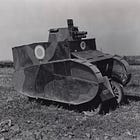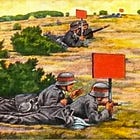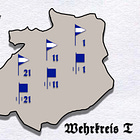Instruction at the Kriegsakademie
Excerpts from an American report from 1938
Between October of 1936 and June of 1938, Captain Albert Coady Wedemeyer of the US Army attended the Kriegsakademie in Berlin. Soon after completing the two-year course for future officers of the General Staff, he submitted a pair of reports. The first of these provided a précis of the approach that the German Army took to tactics, leadership, and organization. The second described, in considerable detail, Captain Wedemeyer’s observations of the curriculum he had followed.
The following article combines excerpts from the second of these reports with explanatory notes. (Readers wishing to read complete copies of both reports can find the first in the book Wedemeyer on War and Peace and the second on the website of the Combined Arms Research Library.
Today, there are approximately 30 instructors, 240 German students and 20 foreign students …
In his memoirs, Wedemeyer mentions that his class at the Kriegsakademie, which represented about half of the student body, consisted of 120 German officers and 9 officers from foreign armies. Of the latter, two came from China, two from Argentina, and one from each of the following countries: Bulgaria, Italy, Japan, Turkey, and the United States.
The instructors are carefully selected, not only because they have splendid military records, but also because of their proven ability to instruct. They serve four years.
About 120 officers (between 28 and 38 years of age) are selected annually as students, after thorough tests, both practical and theoretical …
Emphasis is placed upon the development of the student’s firmness of will, judgement, confidence, acceptance of responsibility, and self-control.1 In the course of the school year, instructors note the presence (or absence) of these characteristics and record same for final evaluation reports.
The present course of instruction lasts two years. However, it is generally believed that the former [before 1914] three-year course will be inaugurated after the army expansion program reaches the desired level.
Instructors
Upon the tactical instructors devolves the greatest responsibility. In addition to their own tactical work, they must coordinate the instruction in all of the other subjects, military history excepted. They serve for one year in the dual role, Tactical Instructor and Commanding Officer, with the same group of students.
The tactical instructors were officers of the General Staff who ranked as majors or lieutenant colonels.
It is their task to constantly observe the latter at work and at play, to evaluate their professional ability and to estimate their character. An efficiency report with appropriate recommendations relative to the future assignment of each student within their respective groups (Hörsaal), must be submitted to the Commandant [of the Kriegsakademie] at the close of each school year.
The Military History Instructors are Retired Generals or Colonels, who have distinguished military records, who have previously indicated outstanding qualifications as instructors and who have made a specialty of their subject.
The other instructors are specialists who carefully coordinate their work with the tactical instructors.
The specialists came from such fields as supply, transportation, mechanized forces, communications, engineering, and aviation.
Subjects Taught
Tactics is considered the most important subject and is therefore allowed the preponderance of study hours. The following are emphasized:
Technique for Orders
Estimate of the Situation [and] Decision
Application of Principles2
In the first year, from October to February, [the students study] the tactical handling of a Reinforced Regiment, technique of orders, estimate of the situation and decision, terrain estimates, and the tactics and technique of infantry and artillery. From February to June, [they explore] the tactical handling of the Infantry Division and of attached Tank Units.
Each student had, as home work: Preparation of a Regimental Inspection, including March to the Exercise Field, a Regimental Combat Exercise, and March in Review at conclusion of Exercises.
The barracks that housed German units were often located in urban areas, and thus at some distance from the training areas used for large-scale field exercises.
In the second year, from October to November, [the students work through] problems involving the Infantry Division. From November to February, [they engage] problems involving the Armored Division, large motorized forces, and the Light Mechanized Division. From February to June [the students deal with] problems involving the corps.
Not to be confused with the cut-down infantry divisions of the last few years of the Second World War, the light division was a fully motorized formation optimized for fast-moving operations ahead of the main body of an army.
[Throughout the second year, students took part in] War Games and Map Maneuvers in which the class is divided into opposing sides … As homework each student prepared a two-sided maneuver involving a division in action for a period of three days.
Military History
During the first half of the first year, students studied the campaigns of Napoleon and Frederick the Great. In the second half of the first year, they conducted a detailed examination of the Tannenberg campaign of 1914.
During the second year students studied the Russo-Japanese War (1904-1905) and the battles of the middle years (1915-1917) of the World War.
In addition to this, each student had to present a 50-minute lecture based on research he conducted on a particular battle.
Methods of Instruction
The students are organized into Study Groups at the beginning of the school year. There are between 15 and 20 in each group. This organization continues for the entire time the officer is a student in the Kriegsakademie. Care is taken in the initial formation that each group contains officers from various branches.
The instructors are officers of exceptional ability and are thoroughly trained in the application of the tactical principles laid down in the German Field Service Regulations (Truppen Führung I). Therefore, sufficient uniformity of ideas in accomplished without creating a too academic and stultified atmosphere.
Practically all of the instruction is imparted through Troop Leading [Truppen Führung]. That is, a General Situation will be issued to the students, often a day in advance, so that they can plot it on the map and read themselves into the situation. The following morning, addition information in the form of a Special Situation may be issued.
As used in the preceding paragraph, Truppen Führung refers to actions involving formations that are larger than regiments (in the Continental/American sense of that word) but smaller than field armies.
The instructor assigns posts of command and staff to the various students. Captain Smith, you are Division Commander. Captain Jones, you are Chief of Staff. Captain Williams, you are Artillery Commander. Captain Ward, you are Commanding Officer, 1st Infantry [Regiment] and so on.
The situation is played as realistically as possible. The instructor may ask the Chief of Staff to state any recommendations that he may wish to make to the Commander. The situation as presented may call for a new decision or it may not. The students determine that important point themselves.
The instructor develops the situation naturally and permits enemy information to reach the Commander, injects difficulties, such as broken lines of communications, important bridge destroyed, sudden appearance of hostile mechanized force on flank or rear, all designed to bring about sound decisions quickly.
The situations presented at the Kriegsakademie involve [a] War of Movement, special emphasis being placed upon speed, in anticipation of the employment of mechanized and motorized forces. The Germans point out, that often a Commander must make an important decision after only a few minutes deliberation and emphasize, that a fair decision given in time for aggressive execution in much better than one wholly right but too late.
For Further Reading:
I suspect that the phrase ‘acceptance of responsibility’ refers to the German concept of Verantwortungs-Freudigkeit. Literally translated as ‘joy in responsibility’, it refers to the willingness of a leader to take difficult decisions in the face of imperfect information.
I suspect that Captain Wedemeyer uses ‘principles’ to translate the German word Grundsätze. If that is the case, a better word might be ‘fundamentals’.









is that rommel seated at the table?
I have always admired the German intellectual & historical approach to war since 1805 and the principles of Auftragstaktik but the appalling inattention to logistics at the operational and strategic level was simply existential martial malpractice.
I have no doubt they mastered a war of movement but Barbarossa proved that once movement ceased and logistics was not optimal, the lack of momentum started to take the edge off the crack units. The defeat of Western Europe in as a rapid a time as they did it was a surprise to most military observers but no one thought the Russian operation would be stymied the way it was.
David Stahel's books make a great case for why logistical immaturity and the mass lack of interoperability on rolling stock would prove fatal.